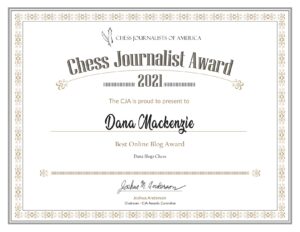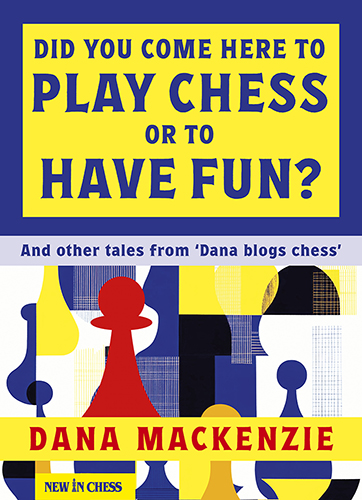For fifteen years, this was the home of “Dana Blogs Chess.” I began writing this blog in 2007, when blogs were the latest and greatest thing on the Internet. In 2021, I won the award for “Best Chess Blog” from the Chess Journalists of America, and I like to joke that they gave me the award only because it was the last blog still standing!
Nevertheless, I decided at the end of 2022 that it was time to retire this blog, because I was no longer playing actively in tournaments (an unfortunate consequence of the pandemic). I also really felt as if I had said everything I wanted to say. See the last post (12/31/2022, “Anticipation of Things Future”) for a more detailed explanation.
In 2023, I started to ask myself if there was some way to preserve a more permanent record of the 1245 blog posts I had written in this space. Thus was born the concept of my new book, Did You Come Here to Play Chess or to Have Fun?
I quickly realized that I couldn’t publish a book with all of my posts. It would have been thousands of pages long! So I selected about 40 of my favorites, edited them, updated them, and in some cases improved the chess analysis that was either outdated or had never been carefully checked. New in Chess agreed to publish my book (now a svelte 264 pages). You can read a couple of sample chapters and order it from their website. Also, of course, you can purchase it from Amazon.com or your favorite online retailer.
Whether you are an old reader coming back here to relive your favorite moments, or a new fan who has just finished reading my book and wants to read more, you’ve come to the right place! All of the old material is still here, in its un-edited and un-improved form, just as I first wrote it. Please pull up a chess board — or fire up your chess computer, according to your preference — and make yourself at home.



Position of the Week
(See the blog post: 7/29/2016)
In this game, I was Black against Colin Chow, a youngster who just a few months later won second place in the World Open under-2400 section.
In the blog post, I describe the game as the most amazing comeback of my chess career. Here White is up an exchange and a pawn, with an f-pawn that is about to promote. What resource does Black have that White overlooked?

“Dana Blogs Chess” Archives
Anticipation of Things Future
Fifteen years ago, when I started this blog, I called the first post Remembrance of Things Past. It seems like an odd way to begin a chronicle that literally had no past at that point. But it gives me a perfect title for today's entry, written on the last day of the...
A Fine Rook Endgame, Part 4
Today I'm going to finish my series of posts on one of the classic rook-and-pawn endgames: the endgame with balanced pawns on the kingside, and with one player enjoying an outside passed pawn on the queenside. The prototypical position is number 367 in Reuben Fine's...
A Fine Rook Endgame, Part 3
I hope you're ready for some very, very challenging endgame analysis! Today we'll have what I think is the most difficult and interesting of my four posts on what I call the "Fine endgame": rook plus 4 pawns versus rook plus 3 pawns, with the stronger side enjoying an...

